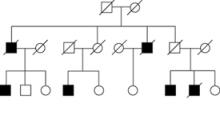
Several clinical and translational resources are available in the study of neurological disease such as genetic and family data.
The National Research Roster for Huntington Disease Patients and Families

The National Research Roster for Huntington Disease is a unique nationwide information resource dedicated to assisting scientific research on Huntington disease.
The National Research Roster for Huntington Disease is a unique nationwide information resource dedicated to assisting scientific research on Huntington disease. The National Research Roster for Huntington Disease Patients and Families was established in 1979 at Indiana University in response to a recommendation from the Commission for the Control of Huntington's Disease and its Consequences. The Roster data is completely confidential and contains computerized information on the names of families, the history of HD in the family and other related data. The goal of the Roster is to serve as a link between patients and families interested in participating in research and scientists interested in studying this disorder. The Roster works to unite patient and scientist in order to encourage successful research studies which may lead to new treatments and an eventual cure.
Contact:
Daniel Miller, Ph.D., NINDS
Related Resources:
National Research Roster for Huntington Disease Patients & Families
NIH Neuroscience Blueprint
Repository for Molecular Brain Neoplasia Data (REMBRANDT)

The goal of the REMBRANDT web portal is to empower translational research for brain tumor studies. REMBRANDT is a joint NCI-NINDS initiative that hosts diverse types of molecular research and clinical trials data related to brain cancers, including gliomas, along with a wide variety of web-based analysis tools that readily facilitate the understanding of critical correlations among the different data types.
The aim of REMBRANDT is to be the access portal for a national molecular, genetic, and clinical database of several thousand primary brain tumors that is fully open and accessible to all investigators (including intramural and extramural researchers), as well as the public-at-large. The data can be downloaded as raw files containing all the information gathered through the primary experiments or can be mined using the informatics support provided. This comprehensive brain tumor data portal will allow for easy ad hoc querying across multiple domains, thus allowing physician-scientists to make the right decisions during patient treatments.
The main focus of REMBRANDT is to molecularly characterize a large number of adult and pediatric primary brain tumors and to correlate those data with extensive retrospective and prospective clinical data. Specific data types hosted here are gene expression profiles, real time PCR assays, CGH and SNP array information, sequencing data, tissue array results and images, proteomic profiles, and patients responses to various treatments. Notably, the genetic/molecular analyses in REMBRANDT are on somatic tissues (tumors) not germline specimens. Clinical trials information and protocols are also accessible.
Contact:
Subhashree Madhavan, Program Director, NCI
Related Resources:
REMBRANDT Web Portal
REMBRANDT Information site
Epilepsy Therapy Screening Program (ETSP) (formerly the Anticonvulsant Screening Program - ASP)
The mission of the NINDS Epilepsy Therapy Screening Program (ETSP) is to encourage and facilitate the discovery of new therapeutic agents for the treatment of epilepsy disorders. The program provides opportunities for researchers from academia and industry in the U.S. and abroad to submit compounds for screening in a battery of well-established rodent seizure models. These tests are performed at a contract facility based at the University of Utah on a blinded and confidential basis and at no cost to the ETSP participants. The NINDS ETSP staff reports test results to participants and provides advice on next steps for promising compounds. Since its establishment in 1975, the program has made important contributions to the development of several FDA-approved drugs for epilepsy, including felbamate (Felbatol), topirimate (Topamax), lacosamide (Vimpat), and retigabine (Potiga). Historically, the ETSP has focused on identifying symptomatic treatments for seizure disorders, but based on recent recommendations from working groups of the National Advisory Neurological Disorders and Stroke (NANDS) Council, the program is placing emphasis on refractory epilepsy, epileptogenesis and disease progression, special epilepsy populations, and epilepsy comorbidities. Other key recommendations implemented include forming an External Consultant Board (ECB) to provide regular feedback to the ETSP and changing the name of the program to reflect the emphasis on identifying differentiated agents to address the unmet medical needs of epilepsy.
Related Resources:
Epilepsy Therapy Screening Program (ETSP)
PANAChE Database
